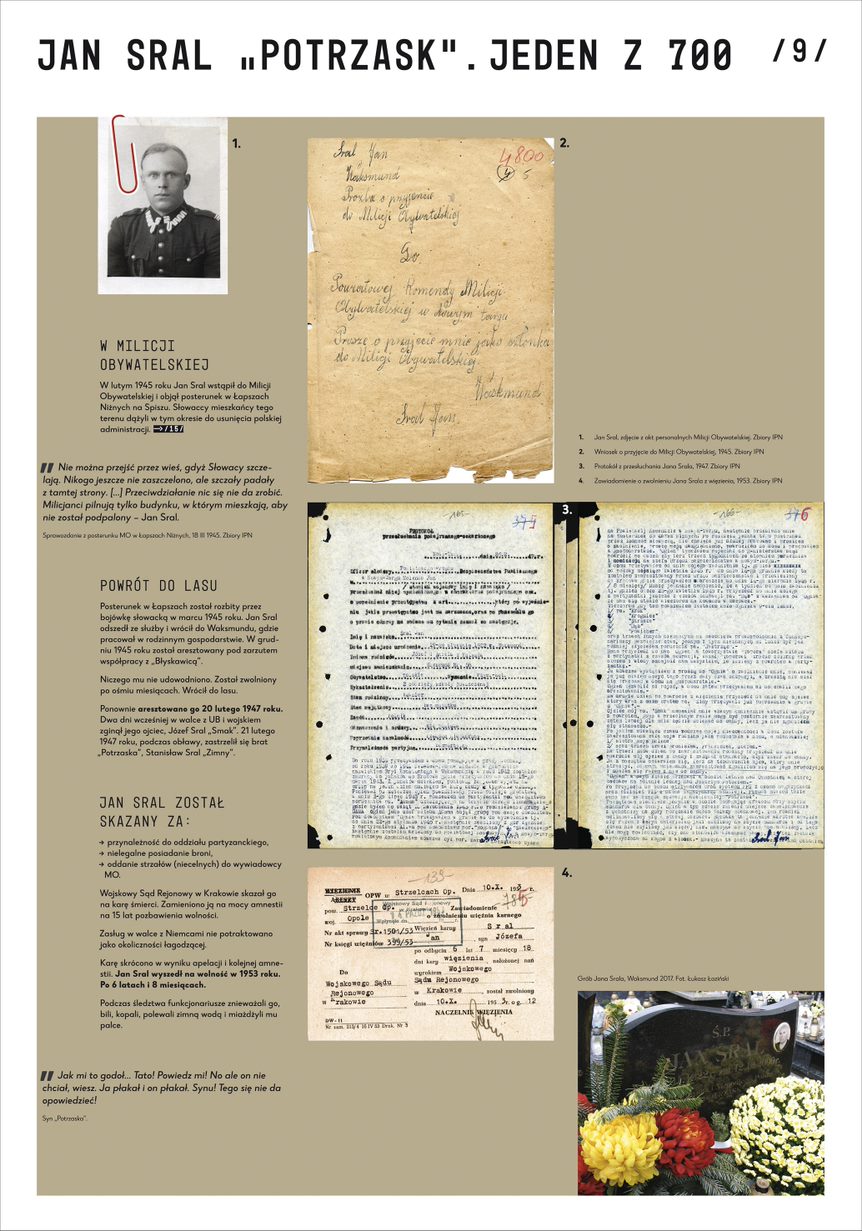
Józef Kuraś “Ogień” is a well-known character. However, he had ca. 700 people serving under his command. One of them was Jan Sral from Waksmund.
He was born in 1922 in a peasant family that had friendly relations with that of Kuraś. His father, Józef Sral “Smak”, served in the Polish Legions. During the Second World War both men became involved with the pro-independence underground.
On 4th July 1943 Jan Sral “Potrzask” witnessed the Nazi pacification of Waksmund. As a member of the resistance, he could have been killed himself.
My daddy escaped to the church, but what’s a church, a church can be searched, right? But he knew this church, because he was from Waksmund, he went up the tower, right to the top […] The Germans did a manhunt and were bringing [people] to the square by the church. People, regularly. And they lay there, dad told me, they lay there their bellies to the ground. They lay on their bellies in the square, and dad was observing that from the tower. […] And he saw that son of a b…ch from Waksmund, the snitch. […] And the son of a b…ch was pointing his finger, showing who was in what organisation, who was from which family, who was a member of the partisans – “Potrzask’s” son.
IN THE WOODS
“Potrzask” joined the Gorce unit of the Home Army, where he served together with his father and “Ogień”. Late in 1943, they left the army as a result of a conflict with the command.
“Ogień” and his trusted men formed their own unit. In spring 1944 they joined the People’s Security Guard, an organisation cooperating with the Government Delegation for Poland. The tasks of managed by “Potrzask” included carrying out death sentences.
At the beginning of 1945, the Red Army entered the Podhale region. It encountered heavy resistance from the German troops, entrenched southeast of Nowy Targ. “Ogień’s” men, very familiar with the lay of the land, showed Soviets the way to attack from the north.
We led them through the mountains over the Dunajec river, as far as the bridge. […] Suddenly, they shot a missile into the sky, and those that were coming from Łopuszna were already at the airport. The second missile came from the airport. And they went hurrah, one by one, with a pepesha gun– Jan Sral.
Robert Kowalski, Wyzwolenie miasta Nowego Targu… “Almanach Nowotarski” 2000-2001
The synchronised manoeuvre of 29th January 1945 was carried out successfully. The rapid liberation of Nowy Targ saved the lives and property of many residents.
Illustrations:
A view of the Tatra Mountains from Waksmund, 2017. Photo by ŁŁ.
[SEATED] Soldiers of the People’s Security Guard in the Gorce Mountains. Jan Sral “Potrzask”, Józef Kuraś “Ogień”, 1944. Collection of the Institute of National Remembrance.
[STANDING] Left to right: Jan Sral “Potrzask”, Józef Kuraś “Ogień”, Jan Kuraś “Kania”, 1944. Collection of the Institute of National Remembrance.
Bridge over the Czarny Dunajec in Nowy Targ, 1918-1939. National Digital Archive.
Nowy Targ Market Square, 1940. National Digital Archive.
IN THE CITIZENS’ MILITIA
After the war Jan Sral joined the Citizens’ Militia and took command of the station in Łapsze Niżne in Spiš. However, the Slovak inhabitants of the region sought to remove the Polish administration.
It’s impossible to pass through the village, because the Slovaks open fire. Nobody has been shot dead yet, but shots were fired from that side. […] Prevention brings no results. Militiamen are only guarding the building in which they live, so that fire is not set to it – Jan Sral.
Report from the Militia station in Łapsze Niżne, 18th March 1945
RETURN TO THE WOODS
The station in Łapsze was destroyed by a Slovak hit squad in March 1945. Jan Sral retired from service and returned to Waksmund, where he worked on the family farm. In December 1945 he was arrested on suspicion of collaboration with the “Błyskawica” group.
The charges against him were not proven, and after eight months he was released. He returned to the woods.
He was arrested again on 20th February 1947, two days after his father, Józef Sral “Smak”, was killed in a clash with the army and the security police. His brother, Stanisław Sral “Zimny”, shot himself during the raid on the unit, on 21st February 1947.
Jan Sral was convicted of:
● Membership in a partisan unit
● Illegal possession of firearms
● Firing shots at (and missing) a militia intelligence officer
The Regional Military Court in Krakow sentenced him to death. Under amnesty, the sentence was commuted to 15 years’ imprisonment.
His contributions in the struggle against the German army were not taken under consideration as a mitigating circumstance.
The sentence was further reduced following an appeal and another amnesty. Jan Sral was released in 1953, having served 6 years and 8 months in prison.
During the investigation, officers insulted and beat him, kicked him, splashed him with cold water, and crushed his fingers.
When he was telling me this… Dad! Tell me! But he didn’t want to, you know. I was crying and he was crying. Son! It is impossible to tell! – “Potrzask’s” son.
Illustrations:
A photograph from Jan Sral’s militia file, 1945. Collection of the Institute of National Remembrance.
Application for admission to the Citizens’ Militia, 1945. Collection of the Institute of National Remembrance.
Notice of Jan Sral’s release from prison, 1953. Collection of the Institute of National Remembrance.
The grave of Jan Sral, Waksmund 2017. Photo by ŁŁ.
Record from the interrogation of Jan Sral, 1947. Collection of the Institute of National Remembrance.
